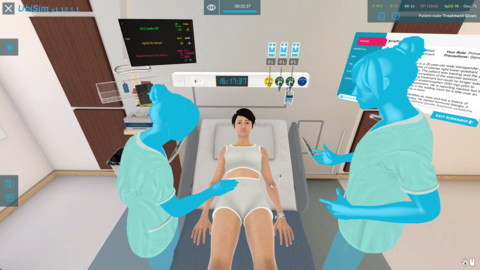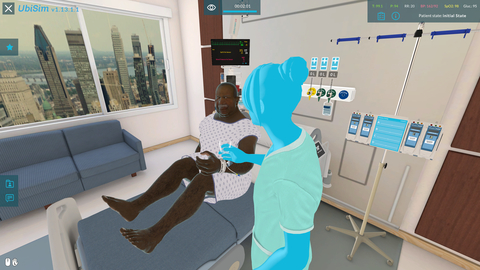MONTREAL & BOSTON– UbiSim, the world’s first immersive virtual reality (VR) training platform built specifically for nurses and nursing simulation by Labster, now includes more opportunities for practicing sensitive therapeutic communications with marginalized patients as well as new functionality for creating custom scenarios. UbiSim version 1.14 includes the first UbiSim nursing VR scenario dedicated to the care of a transgender patient, a VR scenario focusing on an older Black patient with Alzheimer’s disease, and a VR customization for simulating a nasogastric tube insertion.

Realistic simulations and hands-on experiences in a safe environment can help nurse learners develop clinical judgment and communication skills essential to improving Next Generation NCLEX test scores and bolster the soft and hard skills necessary to excel as a nurse. The “anytime, anywhere” accessibility of VR scenarios overcomes limited access to hospitals and other clinical training sites. The complete UbiSim catalog of company-made and user-generated scenarios gives nurse learners the opportunity to practice a large variety of patient encounters based on real-world nursing in the areas of Nursing Fundamentals, Medical-Surgical 1, Medical-Surgical 2, Obstetrics, Pediatrics, and Mental Health, in an inpatient or outpatient setting.
“An enormous benefit of VR-based training is that it allows nurse learners to engage in more frequent practice before they encounter real patients, including in rare, specialized, or critical cases,” said UbiSim Lead Nurse Educator Christine Vogel, MSN, RN, CHSE, CHSOS. “We see the new scenarios as part of our ongoing commitment to prepare nurse learners for safe and effective care for all patients, which includes practicing sensitive therapeutic communications in situations and with people that may extend beyond their previous life experiences.”
The two new scenarios in the UbiSim catalog have the goal of preparing nurse learners to approach transgender patients with sensitivity and respect, and to treat Alzheimer’s dementia sufferers with patience and consideration.
- Alzheimer’s Disease: Patient Morgan Therin, an older Black man, is experiencing agitation and refusing care due to Alzheimer’s disease. Learners practice administering medications and providing therapeutic communication to assist Morgan in this scenario that aligns with Nursing Fundamentals. Research by the Alzheimer’s Association finds that older Black Americans are “twice as likely as older Whites to have Alzheimer’s or another dementia” for still-undetermined causes, and half have experienced discrimination while seeking care for a person living with Alzheimer’s.
- Acute Abdominal Pain: Learners care for Skylar Holmes, a male transgender patient, to practice providing therapeutic communication and nursing care that are sensitive, respectful, and inclusive in this scenario that aligns with Medical-Surgical 1. A new Kaiser Family Foundation (KFF) report found that lesbian, gay, bisexual and transgender (LGBT) adults are “twice as likely as non-LGBT adults to report negative experiences while receiving health care” including being treated unfairly or with disrespect, which made them less likely to seek health care or caused them to switch health care providers.
As part of the UbiSim commitment to scenario diversity and inclusion, a previous platform update added male transgender undergarments in an Obstetrics patient scenario. The option of a gray chest binder and briefs in addition to the previously default pink maternity wear is intended to be representative of a transgender patient who has not undergone gender-affirming surgery.
“Within Labster, our dedication resonates strongly with expanding pathways to inclusive learning via immersive digital engagements in STEM and healthcare,” articulated Shawn Boom, chief executive officer of Labster and parent company of UbiSim. “As we advance and diversify the UbiSim scenario portfolio, our commitment to thoughtfully crafted educational experiences persists. We aim to empower nursing students in their readiness to navigate real-life situations with individuals of diverse backgrounds—embracing patients of all ages, races, ethnicities, genders, and cognitive abilities. We believe this approach will help students enhance their therapeutic communication and elevate their standards of patient care.”
A distinguishing feature of the UbiSim platform is that it enables educators without knowledge of programming or coding to create new VR scenarios and customize existing VR scenarios. For example, scenario creators can select patient, family, and caregiver characters from the existing UbiSim catalog representing a diverse group of races and ethnicities, allowing nurse educators to offer students more opportunities to practice offering culturally competent care.
In addition to the two new scenarios, updates to the UbiSim platform include a major new functionality related to the UbiSim intuitive editor. This innovation introduces a nasogastric (NG) tube, a medical catheter inserted through the nose into the stomach in which gastric suctioning can also be performed. Nurse educators can now customize their UbiSim nursing scenarios by adding an NG tube, while nurse learners are able to install an NG tube on any patient within the simulations.


